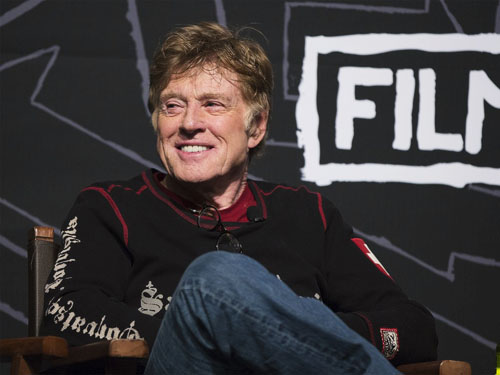
When 76-year-old Robert Redford took the stage at the Egyptian Theatre on Jan. 17 to give his opening remarks for the Sundance Film Festival, he had some interesting things to say.
Redford touched on gun control, diversity and the conservative Utah groups that continue to protest the festival’s presence in their state because of Hollywood’s “moral bankruptcy.” (The same moral bankruptcy that brings the state $100 million in revenue in just 10 days.) He also credited the economic recession with “saving” Sundance.
The festival, which began in 1978, has long been the Mecca of independent film: a place where filmmakers who exist outside the Hollywood system can come to present low-budget work to an audience they might not have found anywhere else, all with the hopes of ultimately selling their films.
By the end of the century, that image of Sundance had become somewhat infested with corporate money and empty fame. Redford talked about being puzzled by Paris Hilton’s attendance one year, which caused him to wonder whether Sundance had become a parody.
Shop owners in Park City even put signs in their windows saying “Locals Only,” and the residents of the snowy Utah town began to dread the influx of black-clad celebrities on cell phones.
But Redford claimed that, this year, Sundance would return to its roots. And at the core of the festival’s mission, according to the man who created it, is the desire to represent a diversity in filmmaking that the studios never really allow.
He seems to have been right. This year’s Sundance festival has resulted in more consummated deals than any in recent history, and it boasted a more exciting lineup than it has in years.
From Jan. 17 to Jan. 27, Park City was inundated with not only celebrities but some of the most talented and remarkable people working in the film industry today. There are so many compelling projects that it’s hard to know where to begin.
Actually, for me, it’s not difficult to know where to begin. Though many critics claimed there was no stand-out film this year equal to last year’s Beasts of the Southern Wild (now an Academy Award nominee for Best Picture), many people are whispering that the best-reviewed film of Sundance 2013 could have Oscar chances after all. It’s Richard Linklater’s Before Midnight, the third film in the trilogy that began with 1994’s Before Sunrise and continued with 2004’s Before Sunset.
The ever-evolving story of Ethan Hawke’s American novelist Jesse and Julie Delpy’s French environmentalist Celine picks up nine years later in Greece, and once again the film consists largely of the two actors wandering around a beautiful European setting having complex conversations.
I have to admit my bias here: Before Sunrise and Before Sunset are pretty much my two favorite films of all time. And I know I’m not alone.
These quintessentially independent films have a legion of passionate followers who will be just as excited as I am that the reviews of Before Midnight have been staggering. Not only do critics say it’s the best of the trilogy, multiple reviews have declared it to be a perfect movie. Perfect! This is one that will get noticed.
For whatever reason, films about sex comprised a large part of the festival this year, from Concussion, about a lesbian housewife who becomes a prostitute, to The Look of Love, in which Steve Coogan plays British porn tycoon Paul Raymond, to Kink, a documentary about bondage pornography produced by James Franco.
But the biggest success story in that category belongs to Lovelace, a biopic about 1970s porn actress Linda Lovelace (star of Deep Throat), who was coerced into the industry by her abusive husband and later became a Gloria Steinem-inspired anti-porn crusader.
Lovelace is played by Amanda Seyfried, known to the masses as the girl from Mamma Mia! She’s an actress I genuinely think more people should love, and she rarely gets to play a lead role like this.
The reviews for her performance have been strong, and with Harvey Weinstein now backing the film, she could actually be looking at a Best Actress nomination. Not to mention it’s being described as a feminist Boogie Nights, and what’s not to love about that?
Both the Grand Jury Prize and the Audience Award were claimed by Fruitvale, the true story of 22-year-old Oscar Grant, a young black man shot by an Oakland police officer in 2009. The film was written and directed by 26-year-old USC grad Ryan Coogler, and Grant is played by Michael B. Jordan (Wallace from The Wire).
Fruitvale is this year’s classic Sundance story of a first-time director getting noticed for the emotional impact of his work, something that Redford must be proud of.
The list of other buzzed-about films at the festival is overwhelming.
Brit Marling and Zal Batmanglij brought their latest film, The East, the story of an anarchist group that attacks big corporations starring Alexander Skarsgard and Ellen Page. Marling and Batmanglij’s 2012 film, Sound of My Voice, was one of the best things I saw last year; they’re an inspired team.
Harry Potter himself, Daniel Radcliffe, is getting rave reviews for his portrayal of a young Allen Ginsberg in Kill Your Darlings. Nicole Kidman and Mia Wasikowska’s twisted family drama, Stoker, has proved controversial with its themes of youth and violence.
And then, of course, there’s Two Mothers, in which Naomi Watts and Robin Wright have affairs with each other’s adult sons.
If Sundance has truly gone from indie to sell-out and back again, it might be an encouraging sign for the film industry in general. At the very least, it proves that there is still a massive range of stories to be told and a massive range of visionary filmmakers to tell them.
That’s enough to give a Hollywood legend like Robert Redford hope for the future, and judging by 2013’s festival, it should be enough to give film lovers everywhere the same.

